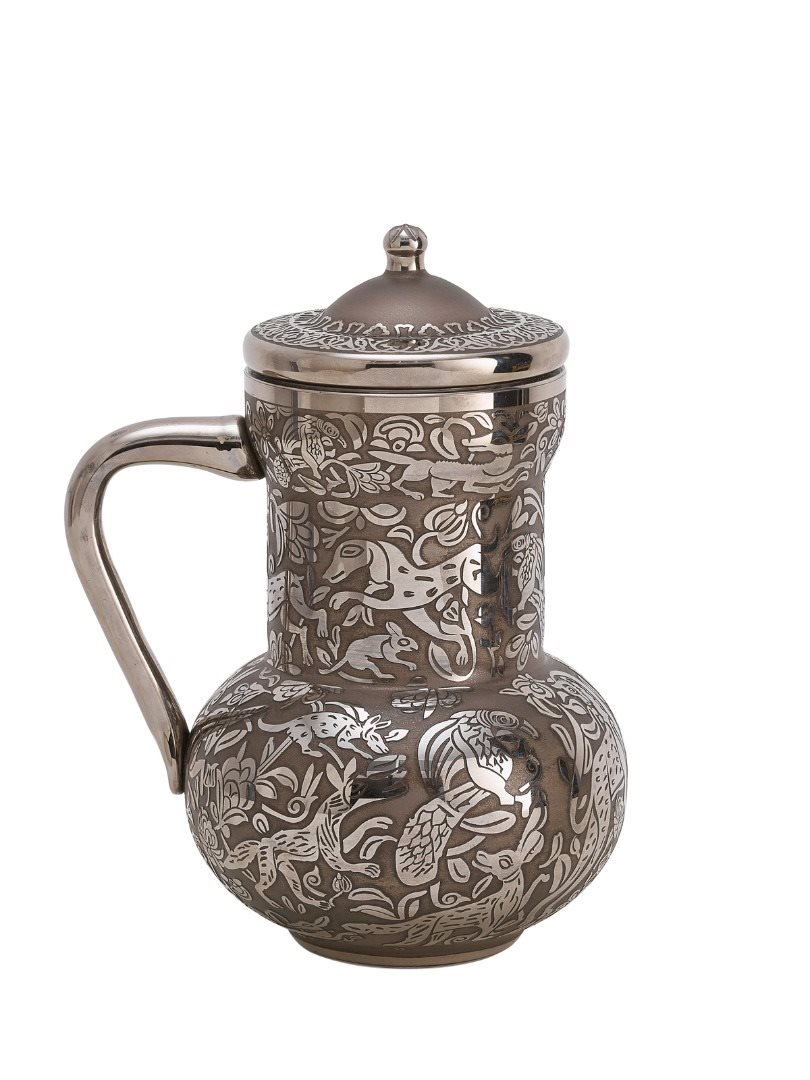Farisi Gümüş Maşrapa
10019776

Döneminin en büyük kültür ve sanat merkezlerinden biri olan İstanbul, 16. ve 17. yüzyıllarda gümüş işçiliğinin de merkezi olmuş ve 19. yüzyılın sonuna kadar bu özelliğini korumuştur. Osmanlı İmparatorluğu’nun en özgün gümüş sanatı işçiliği örnekleri, 16- 17. yüzyıl arasında ortaya çıkmıştır.
Günümüzde Osmanlı Dönemi gümüşleri çeşitli müzelerde sergilenmektedir. Yurt dışına götürülen Selçuklu, Memluk, Timur (Moğol), Endülüs ve Osmanlı dönemine ait İslam eserleri de birçok açık artırmada koleksiyonerlere satılmaktadır. Osmanlılar’da gümüşten imal edilmiş her türlü eşyanın üzerine devrin sultanlarının tuğrasını vurma oldukça eski bir gelenek olduğu için eserlerin ait olduğu dönemler bilinmektedir.
Farisi* Gümüş Maşrapa, yurt dışından geri alınan 17. yüzyıla ait II. Osman tuğralı gümüş bir maşrapadan esinlenerek tasarlanmıştır. Üzerinde hayvan betimlemeleri ve floral desenler bulunmaktadır.
Farisi Gümüş Maşrapa, el imalatı camdan üretilmiştir ve üzerindeki rölyef desenlerin tümü, platin ve eskitme boyalar kullanılarak dekorlanmıştır.
* Farisî; II. Osman’ın (Genç Osman) divan edebiyatında kullandığı takma addır.
Üretim adedi 2.000 ile sınırlıdır
Istanbul, one of the largest cultural and artistic centers of its time, was also the center of silver craftsmanship in the 16th and 17th centuries, and it maintained this feature until the end of the 19th century. The most authentic examples of silver craftsmanship of the Ottoman Empire emerged between the 16th and 17th centuries.
Ottoman silver artifacts, which are considered as invaluable today, are exhibited in various museums all around the world. Islamic works of art from the Seljuk, Mameluke, Timur, Andalusian and the Ottoman periods, which were taken out of Turkey by questionable means, are offered to collectors in many auctions as well. Since it was an established tradition in the Ottomans to imprint the tuğra (calligraphic signature) of the sultans of the time on all kinds of articles made of silver, the periods to which the works belong can be traced easily.
The design of the Farisi * Silver Dipper draws its inspiration from a 17th century Ottoman silver dipper that was brought back to Turkey. It is adorned with depictions of animals and floral patterns.
Farisi Silver Dipper is produced from handmade glass and all of the relief patterns are decorated with platinum and antiquated paints.
* Farisî; was the pseudonym of the 16th Ottoman Sultan, Osman II, also known as Genç Osman (Osman the Young) in diwan literature. Although dethroned and killed at the early age of 17, he was quite an acclaimed poet writing his poems in Persian, thus the pseudonym Farisi, meaning “from Persia”. Diwan, literally meaning inscribed, is a registered collection of poems by one author written in one of the 12 poetic meters.
Çap : 14 cm
Yükseklik : 23,2 cm
% 100 el yapımıdır.
Ürünün Menşei : Türkiye
Temizleme Önerisi : Kuru bezle siliniz
